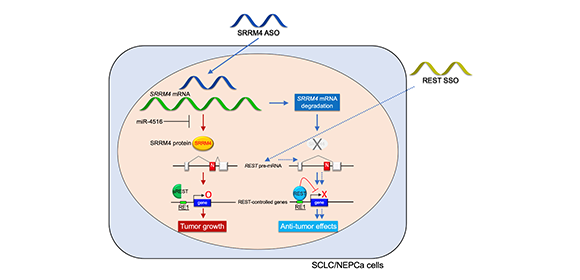
Splicing it all together in the fight against cancer
Researchers from Osaka University develop molecules that can correct improper splicing of a vital tumor suppressor gene in neuroendocrine cancers
Neuroendocrine tumors, including small cell lung cancer and neuroendocrine prostate cancer, are very aggressive with high chances of spreading. However, many individuals develop resistance to few available treatment options, leading to poor patient outcomes. Researchers are therefore aiming to develop new therapeutic methods that focus on the disease-specific molecular mechanisms of these tumors.
In a recent article published in Molecular Therapy: Nucleic Acids, a team of researchers at Osaka University describe a strategy targeting one such mechanism, called RNA splicing.
RNA splicing is the process by which cells remove certain portions of messenger RNA (mRNA) molecules. This produces the mature mRNA that contains the instructions for making a protein for a specific gene. Because incorrect RNA splicing can result in dysfunctional or overactive proteins, this process can significantly contribute to disease development.
The team focused on a protein named the RE1-silencing transcription factor (REST), which typically represses certain genes that support neuroendocrine phenotypes. Interestingly, an abnormally spliced form of REST mRNA is expressed at high levels in neuroendocrine tumors.
“Incorrect splicing of REST mRNA can cause the resulting protein to lose its function, which can lead to neuroendocrine cancer development,” says Keishiro Mishima, lead author of the study. “Our group aimed to develop a molecular method that could be used to correct REST splicing patterns.”
The team used molecules called amido-bridged nucleic acid-based splice-switching oligonucleotides (SSOs). These SSOs were designed to interact with a specific portion of the REST mRNA molecule, allowing it to splice into its normal form. The researchers implanted neuroendocrine cancer cells under the skin of lab mice to form tumors. They then injected the mice into the abdomen with saline or SSO, monitored tumor growth and collected blood samples.
“We examined the levels of certain biochemical markers in the mice serum samples to ensure the SSO treatment did not induce any liver toxicity,” explains Masahito Shimojo, senior author “In parallel, we treated neuroendocrine cancer cell lines in culture with the SSOs to obtain in vitro data to support our in vivo findings.”
REST SSO treatment led to considerably fewer viable cancer cells than the control treatment. In addition, a significantly reduced tumor size was observed in mice injected with REST SSOs. The team then conducted further molecular analyses to examine the expression patterns of the genes that REST typically represses under normal conditions.
“Following treatment, REST-controlled gene expression levels significantly decreased in SSO-treated tumors compared with the control-treated tumors,” says Shimojo. “This indicated that the SSO promoted the restoration of REST function.”
Overall, the study demonstrates that this unique and novel therapeutic approach holds promise for intractable neuroendocrine cancers.
Fig. 1
Graphical abstracts. REST_SSO directly modifies REST splicing and RE1 gene expression, whereas both REST_SSO and SRRM4_ASO exhibit antitumor effects in SCLC/NEPCa.
Credit: 2024 Shimojo et al., Splice-switching antisense oligonucleotide controlling tumor suppressor REST is a novel therapeutic medicine for neuroendocrine cancer, Molecular Therapy Nucleic Acids
Fig. 2
Splicing of REST is regulated by SRRM4-mediated microexon N insertion, thereby lowering functional REST expression in SCLC/NEPCa. REST_SSO induces the skipping of microexon N insertion by interfering with SRRM4 binding, thereby upregulating functional REST expression.
Credit: 2024 Shimojo et al., Splice-switching antisense oligonucleotide controlling tumor suppressor REST is a novel therapeutic medicine for neuroendocrine cancer, Molecular Therapy Nucleic Acids
Fig. 3
Antitumor effects after REST_SSO administration in xenograft mice bearing tumors, originating from the PCa cells. a, Relative tumor volume. b, AST/ALT test using blood samples obtained on day 9. c, Body weight. d, Images of tumors obtained in different groups. e, REST_SSO levels in the tumor, livers, and kidneys were analyzed.
Credit: 2024 Shimojo et al., Splice-switching antisense oligonucleotide controlling tumor suppressor REST is a novel therapeutic medicine for neuroendocrine cancer, Molecular Therapy Nucleic Acids
The article, “Splice-switching antisense oligonucleotide controlling tumor suppressor REST is a novel therapeutic medicine for neuroendocrine cancer,” was published in Molecular Therapy: Nucleic Acids at DOI:

